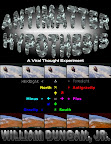In the crowded urban neighborhood, existence is a tight squeeze for hydrogen atoms, who join together into a gang, the jets. Lethal inner neighborhood conflict ensues with a rival gang of indigenous antiparticles. The two gangs claim separate territory and defend boundaries. Border skirmishes annihilate an equal number on each side.
The accretion disk and jet are both visible for HH 30. The calculated speed of the jet is about half a million miles per hour.
Jets emanating in opposite directions from HH 1 and HH 2 encounter resistance and build up pressure at the extremities, similar to mushroom clouds. A high speed jet encountering a slower speed medium produces a bow shock wave.
The jets from HH 46 and HH 47 form bow shaped shock waves in opposite directions.
Here’s a comparison between the size of these different celestial bodies. Notice the label says ‘Young Stars.’ Where does a young star get all that energy and matter? A black hole stores an incredible amount of energy. These jets are like gas geysers. According to the antimatter hypothesis, the opposite gravitational force of a black hole parent and antiparticle accretion disk form a nozzle that accelerates the hydrogen protoplasm to relativistic velocities.
Galaxy M87 exhibits a precessing jet.
Quasars emit radiation that is detected as the red shifted emission spectrum of hydrogen. The energy output of quasars is far greater than any other astronomical event. It’s hard to imagine anything more destructive than a collision between a matter galaxy and an antimatter galaxy. Quasar jets produce nucleosynthesis and excite the emission spectrum of surrounding molecules.
Quasar 3C 273 exhibits a false color relativistic jet decreasing down the electromagnetic spectrum as collisions increase with distance. The black hole is out of the image to the left. X-rays from the Chandra X-Ray Observatory are shown in blue, visible light from the Hubble Space Telescope is shown in green, and infrared light from the Spitzer Space Telescope is shown in red. Other colors like yellow are overlap between the different telescopes. Notice how the spectrum red shifts, both in false color and reality, as the jet slows down.









No comments:
Post a Comment